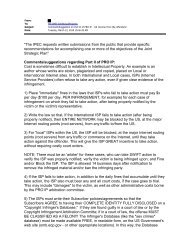We Energies Coal Combustion Products ... - The White House
We Energies Coal Combustion Products ... - The White House
We Energies Coal Combustion Products ... - The White House
You also want an ePaper? Increase the reach of your titles
YUMPU automatically turns print PDFs into web optimized ePapers that Google loves.
pulverized coal furnace burning bituminous coal can be rendered into a usable<br />
fly ash and bottom ash having very low LOI such as produced in a pulverized<br />
coal furnace using subbituminous coals. This can be achieved by adding the<br />
high LOI coal ashes to the coal stream which normally produces low LOI coal<br />
ashes.<br />
<strong>The</strong> bottom ash and fly ash may be handled separately. <strong>The</strong> bottom ash<br />
typically has a larger particle size and may require grinding to reduce it to the<br />
size of the pulverized coal stream. <strong>The</strong> preferred approach for handling of the<br />
bottom ash is to add it to the store of coal prior to the coal being ground.<br />
For instance in original tests conducted in 1996, bottom ash having an LOI of<br />
37.9% and a moisture content of 60.0% was added to loaded coal cars using a<br />
front end loader. <strong>The</strong> bottom ash was added at a ratio of 5% of the coal prior<br />
to unloading in a rotary car unloader. <strong>The</strong> coal cars were then unloaded in a<br />
normal manner and the coal was transported by a conveyor system to one of<br />
five coal silos. <strong>The</strong> bottom ash and coal mixture was then milled and injected<br />
into the boiler with the fuel stream during normal operation in the furnace<br />
along with coal from the other four silos and mills that did not contain bottom<br />
ash. Thus, the actual ratio of bottom ash to coal transported for combustion<br />
was 1% of the overall fuel being burned. <strong>The</strong> addition of the 1% of bottom ash<br />
was not significant from an operational viewpoint. <strong>The</strong>re was no discernable<br />
difference in emissions, and the bottom ash coal fuel blend had adequate<br />
fineness for combustion. <strong>The</strong> fly ash from the reburning of the bottom ash<br />
exhibited a LOI of between 0.2% and 0.4% and has a slightly reduced calcium<br />
oxide content. Bottom ash typically represents less than 20% of the coal ash.<br />
High LOI fly ash can be introduced using four approaches: (1) introduced<br />
with the pulverized coal stream entering the pulverizer classifiers. This has the<br />
advantage of thorough mixing upstream of the burners and would require only<br />
a slight additional volume of air to transport the fly ash; (2) introduced with<br />
the pulverized coal stream at each burner location; (3) introduced with the<br />
secondary air flow stream as it enter the furnace. <strong>The</strong> secondary air flow with<br />
the fly ash provides sufficient mixing; (4) introduced through heat-resistant or<br />
stainless pipes; and (5) introduced into the furnace either above or adjacent to<br />
the existing burner level through separate pipes. Injection points through a<br />
waterwall could be used, although this may require modifications of the<br />
waterwalls in the boilers.<br />
For instance in original tests conducted in 1996, a fly ash having an LOI of<br />
26.5% and a moisture content of 0.3% was introduced into a coal pulverized<br />
furnace through injection pipes. <strong>The</strong> fly ash was stored in a horizontal silo<br />
from which it was pumped through stainless steel pipes extending through the<br />
furnace wall immediately above two coal burners. <strong>The</strong> hose was connected to<br />
a reducer splitter where the 5” diameter hose was reduced to two 2” diameter<br />
hoses. <strong>The</strong> fly ash was pumped at a rate of approximately 1% –2% of the coal<br />
flow into the furnace. <strong>The</strong> addition of the fly ash to the combustion did not<br />
<strong>We</strong> <strong>Energies</strong> 178<br />
<strong>Coal</strong> <strong>Combustion</strong> <strong>Products</strong><br />
Utilization Handbook



